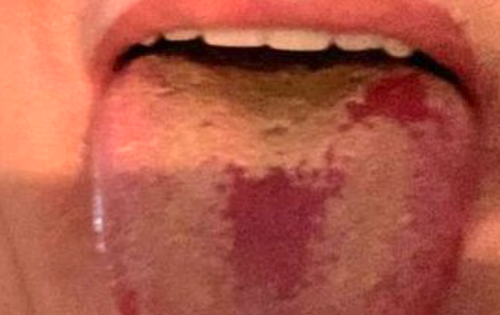

More people are presenting with ‘Covid tongues’ and ‘strange mouth ulcers’ after coming down with coronavirus, according to the professor leading the UK’s Covid Symptom Study app.
Prof Tim Spector, an expert in genetic epidemiology at King’s College London, tweeted a photo of a person’s tongue coated with white patches. He said one in five people with Covid still have less common symptoms that don’t appear on the official symptoms list. His app has been monitoring people’s self-reported symptoms since the beginning of the pandemic.
The NHS only lists three key symptoms of Covid-19: a fever, persistent cough and loss or change to your sense of smell or taste. But other symptoms people with the virus have experienced include rashes, headaches, and digestive issues like nausea and diarrhoea. Further symptoms, according to the World Health Organisation (WHO), include tiredness, aches and pains, sore throat, conjunctivitis, and discolouration of the fingers or toes.
Spector urged anyone who has “a strange symptom or even just headache and fatigue” to stay at home.
So what do you need to know about so-called Covid tongue?
Dr David Strain, who works as a clinician at the Royal Devon and Exeter Hospital, says it’s something he sees in hospital patients who have tested positive for Covid-19 “pretty frequently”.
“At first we were treating it as if it was oral thrush (candidiasis) but it didn’t appear to respond,” he tells HuffPost UK. “Now we just observe it and note that it gets better – usually about the same time the sense of taste gets better.”
Gabriel Scally, president of epidemiology and public health at the Royal Society of Medicine, told The Sun symptoms in the mouth have been described for some time in association with Covid-19. “It is such a problematic virus to treat as it produces effects in such a wide range of body systems,” he said.
While patches on the tongue could signal Covid, it’s important to note that coating can appear on the tongue for a vast number of reasons. So just because a patch crops up on your tongue, it doesn’t mean you have Covid-19.
What could changes happening to your tongue mean, then?
Oral and maxillofacial surgeon Peter Dyer, the British Dental Association’s chair of hospital dentists, previously told HuffPost UK that when a white coating appears across the whole of the tongue, it’s usually caused by a build-up of cells on the surface. This could be because of irritation or food debris. In babies, it can be due to a build-up of milk. This is an oral hygiene issue, rather than a health issue, so doesn’t require treatment.
Red and white patches in the mouth can be caused by thrush, which is a fungal infection, says British Dental Association spokesperson Professor Damien Walmsley. “The white patches usually rub off, leaving a sore red patch underneath,” he tells HuffPost UK. Such patches are usually an indication that a person is run down, Dyer noted. It could also occur in those who have been taking antibiotics, or using asthma inhalers.
Anti-thrush medication can be used to treat the issue, prescribed by your dentist or GP. “Oral thrush is usually harmless,” states the NHS. ”[It] can be easily treated with a mouth gel. Treatment usually lasts at least seven days.”
Isolated (single) white patches on the tongue “can be a bit more worrying,” explained Dyer – especially if you have a normal, healthy pink tongue. It’s not always serious – it could be down to the fact the tongue is rubbing against a tooth or filling – but there’s also a chance it could indicate oral cancer.
A localised white patch or red patch which has been there for more than three weeks should be checked out by your dentist or GP. If you have anti-fungal treatment, and the patches go away, it means they are not related to cancer, adds Prof Walmsley.
There is also a harmless condition, well known to dentists, called geographical tongue, he says. It’s called this because irregular white patches make the tongue resemble a map. “It’s a rare condition that only affects around 2% of the population, and at present there is no connection with Covid, oral cancer or any other medical condition,” says Prof Walmsley.
“It’s possible that because the condition is so uncommon people may assume it is linked to Covid. If you are concerned about changes in your tongue, speak to your dentist.”
Is there any further evidence of ‘Covid tongue’?
There is little information on geographic tongue in Covid patients, however case reports suggest it is occurring – although how commonly, we don’t know. One case report told of a 27-year-old man in Japan who had a sore throat and persistent upper gastrointestinal symptoms for approximately two months. He showed a “slight sign of geographic tongue” on day 59 of being monitored and a Covid-19 test came back positive two days later.
An article in the International Journal Of Infectious Diseases reported a case of an oral condition in a patient diagnosed with Covid-19. The 67-year-old Caucasian man tested positive for coronavirus and had mouth symptoms such as recurrent herpes simplex, candidiasis (thrush), and geographic tongue.
Despite some evidence, ‘Covid tongue’ is not an official symptom listed by the NHS. If you have a fever, persistent cough, or a loss or change to your sense of smell or taste, you can apply to have a Covid-19 swab test.
A Department of Health and Social Care Spokesperson tells HuffPost UK an expert scientific group keeps the symptoms of Covid-19 under constant review.
“Anyone experiencing the main symptoms of coronavirus – a high temperature, a new continuous cough, or a loss or change to sense of smell or taste – should get a test as soon as possible,” they add.